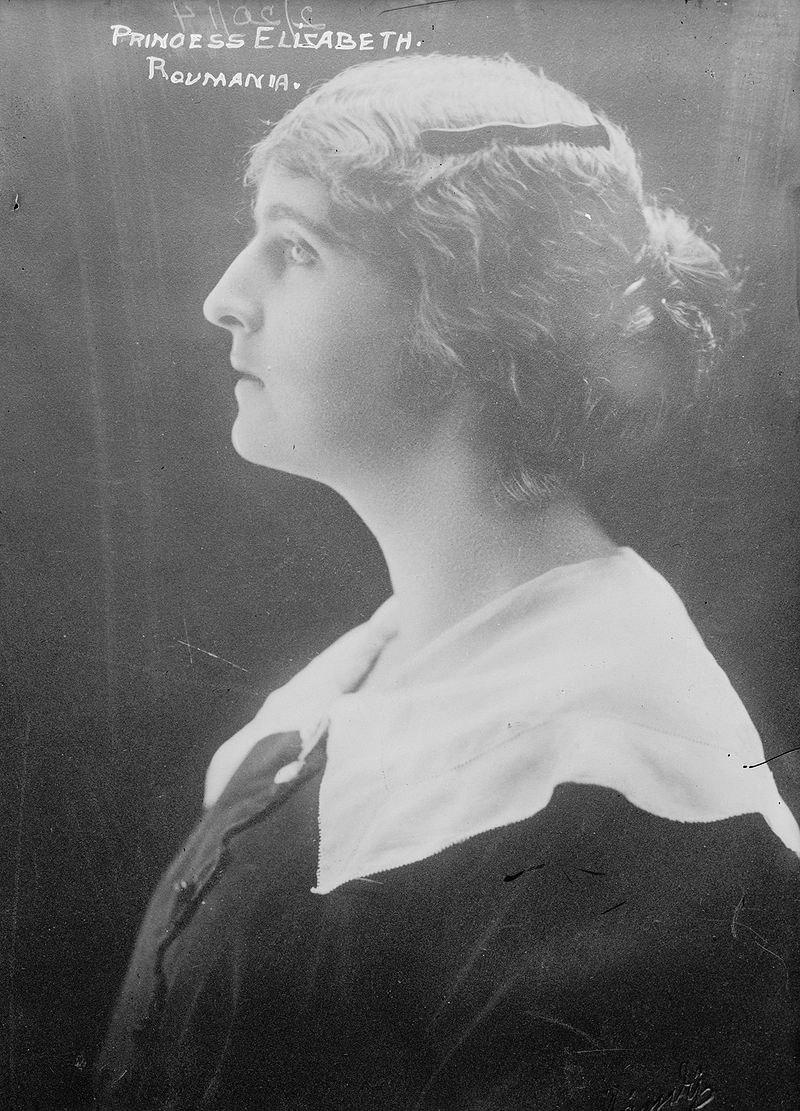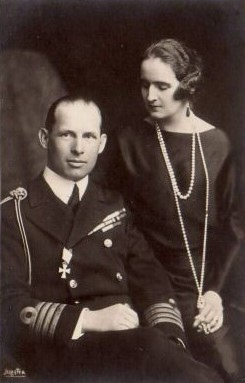by Scott Mehl © Unofficial Royalty 2016

Princess Elisabeta of Romania, Queen of the Hellenes; Credit: Wikipedia
Princess Elisabeta of Romania was the wife of King George II of the Hellenes from 1921 until 1935. She was born Elisabeta Charlotte Josephine Alexandra Victoria on October 12, 1894, at Peleş Castle in Romania, the eldest daughter of King Ferdinand I of Romania and Princess Marie of Edinburgh. Elisabeta had five siblings:
- King Carol II (1893-1953), married (1) Ioana “Zizi” Lambrino, had issue; (2) Princess Helen of Greece and Denmark, had issue; (3) Elena “Magda” Lupescu, no issue
- Princess Maria, Queen of Yugoslavia (1900-1961), married King Alexander I of Yugoslavia, had issue
- Prince Nicholas (1903-1978), married (1) Ioana Doletti, no issue (2) Thereza Lisboa Figueira de Mello, no issue
- Princess Ileana (1909-1991) – married (1) Archduke Anton of Austria-Tuscany, had issue; (2) Dr. Stefan Issarescu, no issue
- Prince Mircea (1913-1916), died from typhoid fever at age 3

Elisabeta on her mother’s lap with her brother Carol, c1895. source: Wikipedia
Elisabeta was raised by her great-aunt (and namesake) Queen Elisabeth, the wife of King Carol I of Romania. As a child, she learned to play the piano and violin and quickly developed a talent for drawing and painting. Educated privately at home, she spoke several languages and furthered her skills in music and art. She also began her charitable work at a young age. Along with her sisters, Elisabeta often joined their mother in her nursing work during World War I. After the war, she spent a year studying art and music in Paris.

Queen Marie, Princess Elisabeta, and Princess Maria in Paris, 1919. source: Wikipedia
Elisabeta first met her future husband in 1911, when the Greek Royal Family had been invited to visit the Romanian Royal Family. Prince George (later King George II) was the son of King Constantine I of the Hellenes and Princess Sophie of Prussia. George and Elisabeta were second cousins through their mothers. During the visit, George proposed but Elisabeta declined. He proposed again in 1914 after the Balkan Wars but she again turned him down. The two maintained contact and George’s luck would soon improve. In early 1920, while traveling from France with her mother and sisters, they stopped in Switzerland where the Greek Royal Family was living in exile. George proposed again, and this time, Elisabeta accepted. The engagement was announced in October 1920 and they married on February 27, 1921, in Bucharest, Romania. By the time of the wedding, George’s father had been restored to the Greek throne. Elisabeta became the Crown Princess of Greece and the Duchess of Sparta. A week after their return to Greece, a second wedding took place in Athens. Elisabeta’s brother, Carol, married George’s sister, Princess Helen of Greece. Neither marriage would prove to be a happy one.

Elisabeta and George, 1921. source: Wikipedia
The Crown Princess found her new life in Greece to be very difficult. She did not speak the language and often felt snubbed by many in her husband’s family. The couple did not have their own home but lived with King Constantine and Queen Sophia. Trying to make the best of the situation, Elisabeta quickly set out to redecorate their apartments but soon found that there was little money to do so. The Greek Royal Family did not have the same financial resources to which she was accustomed, and her dowry was not much help.
Elisabeta began working with the Red Cross and indulging in her love of painting and gardening. She also worked hard to learn Greek hoping it would help her relationships with her new family. Soon she found herself pregnant, but suffered a miscarriage and then fell ill with typhoid. Having recovered, she returned to Romania in the fall of 1922 to attend her parents’ coronation. While there, Elisabeta learned that her father-in-law had abdicated in favor of her husband. She was now Queen of the Hellenes.
Days after her parents’ coronation, Elisabeta returned to Greece. However, she shunned the typical duties expected of a consort, preferring to spend time at Tatoi Palace where she could paint, play the piano, and spend hours working in the gardens she had designed there. Soon, it became likely that the Greek monarchy would be eliminated in favor of a Republic. Under the guise of an official visit to Romania, Elisabeta and her husband went into exile on December 19, 1923. They settled briefly at Cotroceni Palace before taking the lease on a small villa in Bucharest. Just months later, on March 25, 1924, King George II was formally deposed.
Soon, the couple began to grow apart. Elisabeta was happy to be back in her homeland, while George felt stifled at the Romanian court. He spent more time abroad, and by the early 1930s, was living permanently in London. Both had begun affairs and in 1935, Elisabeta filed for divorce in Bucharest, citing desertion as the grounds for divorce. The divorce was issued on July 6, 1935, and her former husband found out when he read about it in the newspaper. He had never been made aware of the proceedings.
Elisabeta then petitioned to have her Romanian citizenship restored (she had relinquished it upon her marriage). Through shrewd investments and the booming Romanian economy, she became financially well-off. In March of that year, she had purchased Banloc – a commune in western Romania made up of several villages where she lived at Banloc Castle. In Bucharest, the Elisabeta Palace was built for her in the mid-1390s. She also had a home in the village of Copăceni, outside of Bucharest. Elisabeta devoted much of her time to charity, working with many organizations to help children and those who were ill. At her own expense, she established a hospital and children’s home in Bucharest.
By 1944, Elisabeta had given up the Elisabeta Palace to her nephew King Mihai who moved his court there following the bombing of the Royal Palace in Bucharest. She spent her time at Banloc and Copăceni. It was there, on December 30, 1947, that King Mihai was forced to abdicate. Just days later, on January 4, 1948, the royal train carrying King Mihai, Queen Mother Helen, and Princess Ileana left Bucharest and traveled to Banloc, where Elisabeta joined them on their journey out of Romania. After staying briefly in Sigmaringen, Germany, and in Zurich, she eventually settled in Cannes, France where she leased an apartment and later taught piano lessons.
Princess Elisabeta of Romania, Queen of Greece, died in Cannes, France on November 15, 1956. She is buried at the Hedinger Church in Sigmaringen, Germany.
This article is the intellectual property of Unofficial Royalty and is NOT TO BE COPIED, EDITED, OR POSTED IN ANY FORM ON ANOTHER WEBSITE under any circumstances. It is permissible to use a link that directs to Unofficial Royalty.
Greece Resources at Unofficial Royalty
